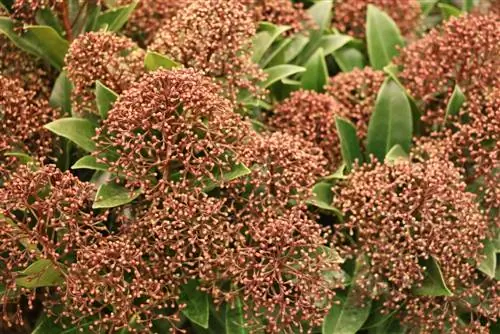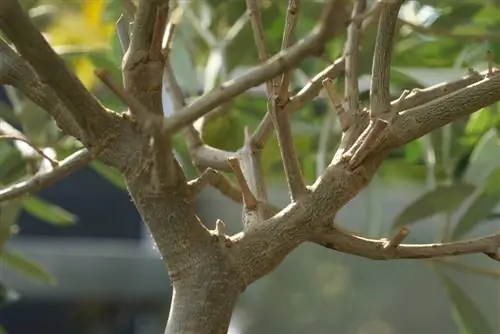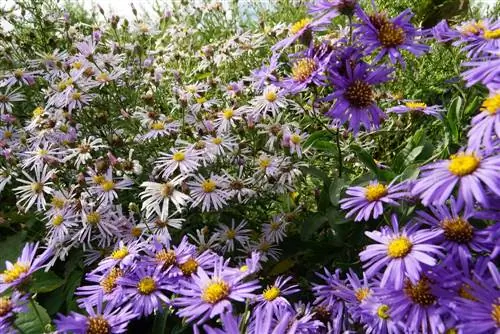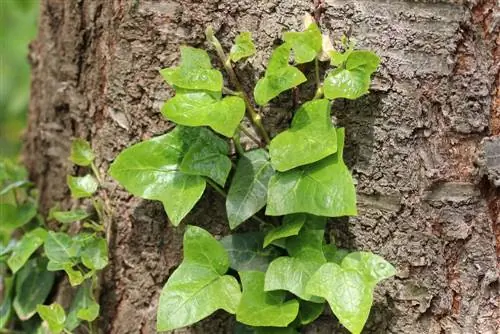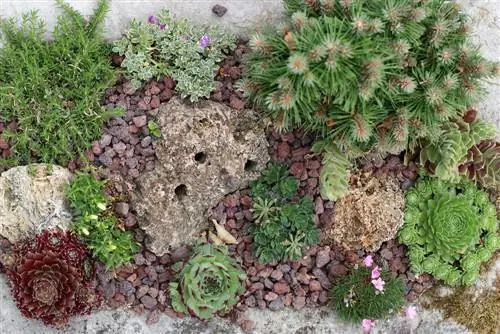- Author admin [email protected].
- Public 2023-12-17 03:39.
- Last modified 2025-01-24 12:45.
A moor bed creates the incomparable aura of raised moors in the garden, which can only be found in nature in northwest Germany. Characterized by permanently moist soil, poor in nutrients and slightly acidic, a very specific flora thrives here. The following list of ericaceous plants reveals which species have adapted excellently to these extreme conditions. Here you will encounter flowering, hardy and some unexpected plants that will add another attraction to your garden.
Flowering ericaceous plants
They are the superstars in the swamp bed, because the following plants produce an abundance of flowers despite the extreme conditions.
Rhododendron
In early summer they enchant the garden with colorful flower clusters. Rhododendron impresses with a we alth of multi-faceted varieties, from evergreen to summer green, from dwarf shrubs to large trees.
- Growth heights from 30 centimeters to 8 meters
- For bright, partially shaded, cooler locations
Azalea
The small relatives of the rhododendron impress with their compact habit and an exuberant display of flowers from May to July. Since the majority of all varieties are hardy, they are one of the most popular ornamental trees for moorland beds.
- Growth heights from 20 to 60 centimeters
- Sunny to partially shaded locations
Shadow Bells (Pieris)
The evergreen heather plant attracts everyone's attention in April and May with bright white flower spikes above lush green foliage. As if that weren't enough in terms of decoration, the buds for next year appear in an enchanting pink color in autumn. Throughout the winter, shadow bells delight the eye of the beholder with this decoration.
- Growth heights up to 100 centimeters
- Is one of the poisonous plants
Peat myrtle (Pernettya mucronata)
Within the large heather family, the peat myrtle stands out impressively. It enchants with a decorative flower in white to soft pink, followed by wonderful pink berries in autumn.
- Growth heights from 50 to 100 centimeters
- Winter protection recommended from -10 degrees Celsius
Winter-hardy ericaceous plants
While some flower beauties in the swampy cultivated bed sometimes require winter protection, the following plants do not mind frost and cold.
Cranberry (Vaccinium oxycoccus)
Where a decorative ground cover is to be planted in the bog bed, the small cranberry with evergreen foliage, pink flowers and edible berries is recommended. The best-known representative of this genus is probably the large-fruited cranberry (Vaccinium macrocarpon), also known as the cranberry.
- Creeping growth with tendrils up to 1 m long
- Berries taste especially good after the first frost
Peat moss (Sphagnum)
They form the heart of every bog bed because they are responsible for various ecological tasks. Since they thrive in both peat soil and water, peat mosses create the basis for bog formation. In addition, sphagnum provide protection and food for numerous small animals.
- Unlimited growth possible
- Considered extremely endangered
Skimmia (Skimmia japonica)
There should be at least one large shrub in the large moorland. Skimmia japonica is considered an ideal candidate because, as an evergreen shrub, it reaches heights of up to 150 centimeters. In addition, it decorates the bed with white flower spikes and eye-catching berries in bright red.
- Popular bee and bumblebee pasture
- Is one of the least poisonous plants
Blue Pipe Grass (Molinia caerulea)
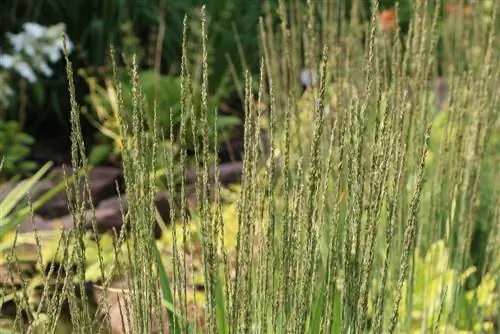
The delicate sweet grass scores with shimmering blue ears and decorates the garden even during the cold season. In sunny places, the pipe grass develops dense clumps that offer overwintering small animals a safe place to sleep.
- Growth heights up to 120 cm
- Pruning only required in spring
Bell heather (Erica tetralix)
With its large flowers, the bell heather puts other Erica species in the shade. Since it consistently insists on moist, acidic soil, it is often referred to as bog bell heather. The beautiful, umbellate inflorescence consists of up to 15 individual flowers in light pink.
- Growth heights from 15 to 50 cm
- Does not tolerate direct sun
Eriophorum vaginatum
With delicate fruit heads that are reminiscent of cotton balls from a distance, cotton grass enriches permanently moist areas of the garden. The spiked inflorescences, on the other hand, are hardly noticeable. Since, unlike other ornamental grasses, it does not form runners, its spread can be easily controlled.
- Growth heights from 20 to 70 cm
- Twice flowering in spring and midsummer
Moorbed Orchids
The following tropical and native orchids thrive exceptionally well in the garden's moorland:
Moor Pogonia (Pogonia ophioglossoides)
One of the most spectacular orchids for the unique cultivation conditions of a moor biotope enchants in June and July with wonderful, light pink flowers on 20-25 centimeter high stems. Thanks to its vigor, the Moorpogonia forms a magnificent carpet of flowers within a short time.
- Diameter of flowers up to 3 cm
- Completely hardy
Sphagnum orchid (Dactylorhiza majalis ssp. sphagnicola)
Native to the German-Dutch border area, this native orchid species has a robust constitution. It is therefore often used to give renatured moor areas a special magic with its pink flowers.
- Growth heights from 20 to 60 cm
- No winter protection required
Ständelwurzen (Epipactis)
In this genus within the orchid family there are several candidates for the bog bed. The Great Stendelwort (Epipactis gigantea), for example, is so flexible that it also thrives in the more nutrient-rich soil of a fen. The pretty cultivar 'Sabine' (Epip. palustris x Epip. gigantea) also feels at home along the Garden Kingdom.
- Growth heights from 30 to 80 cm
- Cushion-forming and hardy
Spiranthes “Chadds Ford”)
When the vast majority of summer flowers have completely exhausted themselves, the hour of rotary roots strikes. The variety 'Chadds Ford' adorns the swamp bed with bright white flowers well into autumn and exudes an intoxicating scent of vanilla.
- Growth heights from 20 to 50 cm
- Light winter protection recommended
Carnivorous plants for ericaceous bed culture
Hobby gardeners with a penchant for carnivores do not limit the cultivation of these spectacular plant species to the home. There is an exciting mix of native and exotic varieties available, which attract many a curious look over the fence in the garden's moorland.
Long-leaved sundew (Drosera anglica)
Within the second largest genus of carnivorous plants, the long-leaved sundew is one of the few species that thrive in the Central European climate. Characteristic of this plant are the reddish tentacles with which the plant catches insects. Together with its two conspecifics, the medium-sized sundew (Drosera intermedia) and the round-leaved sundew (Drosera rotundifolia), creative gardeners create a varied appearance in the swampy biotope.
- White flowers from June to July
- hardy
Common butterwort (Pinguicula vulgaris)
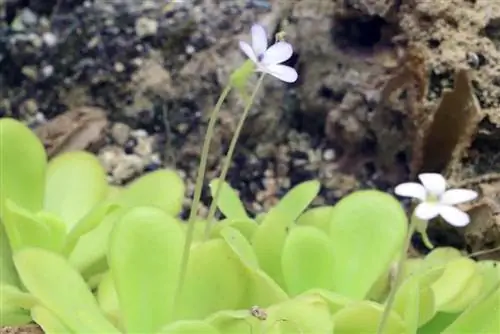
The delicate plant forms a rosette of leaves lying flat on the ground, from which a 16 centimeter high inflorescence rises from May to August. It is not the pink-purple flowers with which butterwort catches small insects, but rather the leaves, which are covered with a secretion.
- Growth height 14 to 16 cm
- Thrives in both acidic and calcareous soil
Pitch Plants (Sarracenia)
An indispensable part of a carnivore bog bed are the multi-faceted pitcher plant species. They trap all kinds of insects with their trumpet-shaped leaves. The colorful flowers that open shortly before the leaves in spring are pretty to look at in order to attract bees as pollinators, which at this point still survive.
- Growth heights from 10 to 100 cm
- Winter quarters required at 5-10 degrees Celsius
Conclusion
The exceptional growing conditions in a moorland require plants that have adapted to the special character. If you delve into the list of ericaceous plants, you will come across flowering and winter-hardy classics such as rhododendron or skimmie. On the other hand, exotic plants, which, according to popular understanding, are most likely to be found in a moorland biotope, cause incredulous astonishment. These include native and tropical orchids, such as the bog pogonia or the sphagnum orchid. Creative hobby gardeners add a touch of extravagance to beds with permanently moist, acidic cultivated soil by planting carnivorous plants.

